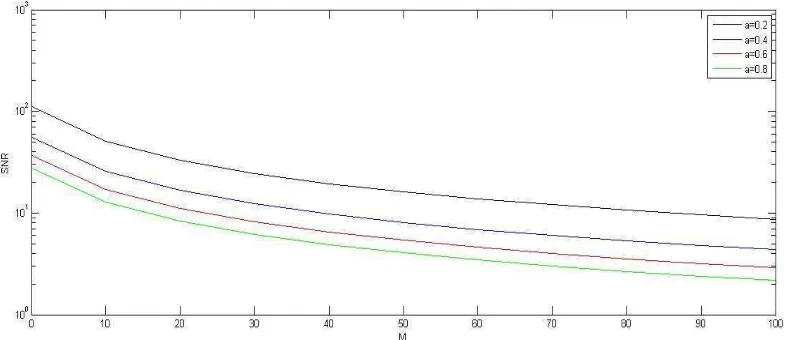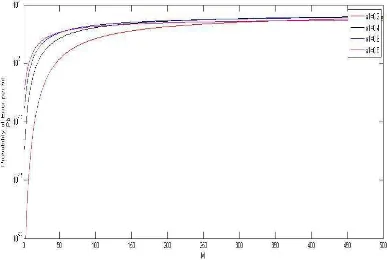ISSN: 1693-6930
accredited by DGHE (DIKTI), Decree No: 51/Dikti/Kep/2010 165
Performance Analysis for Bit-Error-Rate of DS-CDMA
Sensor Network Systems with Source Coding
Ali M. Fadhil1, Haider M. AlSabbagh*2
1
Department of Computer Engineering, College of Engineering, University of Basra, Basra, Iraq
2Department of Electrical Engineering, College of Engineering, University of Basra, Basra, Iraq
e-mail: [email protected], [email protected]
Abstrak
Salah satu teknik terkenal yg digunakan dengan jaringan sensor nirkabel untuk mengakses jaringan adalah memanfaatkan akses jamak pembagian sandi runtun langsung. Jumlah energi yang dikonsumsi dan antar pengguna masih dianggap sebagai masalah utama dengan menggunakan jaringan tersebut. Energi yang dikonsumsi dan interferensi meningkat ketika jumlah pengguna (penerima) meningkat. Penelitian ini dilakukan untuk menyelidiki pengaruh faktor mitigasi melalui analisis penyandian energi minimum yang mengeksploitasi bit redundan untuk menghemat listrik, dengan menggunakan link radio frekuensi dan modulasi on-off-keying. Faktor-faktor ini dianalisis dan dibahas untuk beberapa level galat yang diharapkan dengan memanfaatkan saluran, melalui laju galat bit dan rasio sinyal dan derau pada beberapa pengguna yang berbeda.
Kata kunci: DS-CDMA, laju galat bit, sensor nirkabel
Abstract
One of the distinguished techniques used with wireless sensor networks to access the network is utilizing direct sequence-code division multiple access. However, amount of consumed energy and multiple access interference are still considered as the main problems with employing such networks. The consumed energy and interference are rising when number of users (receivers) increases. Therefore, this paper is conducted to investigate mitigating influence these factors through analyzing the minimum energy coding which exploits redundant bits for saving power with employing radio frequency link and on-off-keying modulation. These factors are analyzed and discussed for several levels of expected errors in the utilizing channel, through the bit error rates and amount of signal to noise ratio for different number of users.
.
Keywords: bit error rate, DS-CDMA, wireless sensors
1. Introduction
In this paper, influence of the bit error rate on the signal to noise ratio for number of receivers is analyzed. Also, amount of energy for receiving bits is investigated for the SNR and BERs. Then, effect number of users on the probability of received bits is studied. The achieved results indicate that the SNR is dependent on the amount ratio of energy per bit to node density in the used field.
The rest of the paper is outlined as follows. Section 2 includes the model for the system and the achieved results are presented in section 3. Then, the conclusions are drawn to section 4.
2. The System Model
The model for the transmission signal is evolved in this part in order to analyze the system characteristics, represents the general DS-CDMA systems with number of receivers (N). Let the transmitted signal is given by [7, 8]:
() =∑ேୀଵ2m−. (−)cos (−) (1)
Where Pk is the power of the transmitted signal, is the common carrier angular frequency, θk is the phase shift offset, m() and () are the data and spreading signals for the kth
received signal, respectively, and is a random transmission delay calculated with respect to reference transmitted signal. It is accounting for the lack of synchronization among the users. The data signal and the spreading signal are given as:
m=∑∞ୀ∞m∏(, (+ 1)) (1-a)
=∑∞ୀ∞C∏(, (+ 1)) (1-b)
where ∏(ଵ,ଶ) is a unit rectangular pulse on [t1,t2).
To keep generality on this interesting case, consider ∈ [0,) and ∈ [−,] since the analyses are conducted in the time delays module, T, and phase delays module, 2π. Thus the de-spread demodulated signal Sd(t) can be given as:
Sd(t)= ∑
With taking into account influence of noise in the utilizing channel, we can rewrite Eq. 1 to be as:
The output of the correlation receiver for user 1, at t = Tb is=ଵ+ଵ+, where ଵis the desired received signal for user number 1, ଵis the interference from other users and is the AWGN term with variance of /2. In other words, the three terms are: SNR is a perfect index to evaluate the quality of the received signal. So, to find the (SNR), the signal power of the ଵ() is computed as
Where
1is the percentage of high bits for m1(t) during the transmission duration of T second.The MAI and AWGN powers can be shown to be
Pn1= ଵଶ N0 Tb / 4 + ∑
(
1݇
ܯ
ܭ=2 Pk / 2 ) σ
2
(6)
So, the SNR in the energy-efficient DS-CDMA system can be found as
SNR = P1ଶ /((
1N0Tb/2) +∑
ଵ
been presented in the literature over the past couple of years. The approach that first appeared in [7] is followed in this study. And, the MAI is assumed sufficiently well represented by an equivalent Gaussian random process with assuming that the power control for all the transmitters signals arrive at the receiver of transmitter high bit for each transmitter are same, i.e., 1 = 2 = …=݉
.. For such condition Eq. (7) can be further simplified asThe bit error usually occurs in moving from high bit signal into a lower bit signal or vice versa. The average error probability of reciver1 for transmitting one bit as:
=.≥"|= 0$+ଵ.<"|= 1$ (9)
=+∑ேୀଶଶೖ()(,,) (10)
If m0(t) = 1, the output of the integrator can be explained to
ଵ=+ଵ/2 (11)
Let δ=
1/2
Tb, we have =(ଵ).≥ଵ/2+ଵ(ଵ).<ଵ/2 (12)
As SNRME approach constant, ∑MK=2
(
ɑK pk/2) σ 2i(k)→∞ as M→∞ and P0(t)>>P1(t) under these
condition, under these condition we can simplify Pb as:
Pb = (1- ɑ1) Q(
SNR
ME) (13)where Q(x)= 1 ඥ2ߨ
ݑ2/2
∞
ݔ
du
.3. Results and Analysis
Figure 1 illustrates variation of the SNR to the number of users (receivers). The SNR increases for different values of the percentage of high bits for ଵ() during the transmission duration of T second ( ଵ) when the number of users increases the interference with the users are increased. Thus such behavior leads to increase amount of the MAI power and the SNR decreases.
Figure 1. SNR for DS-CDMA energy efficient to the number of users and different values of ଵ.
Figure 2 shows that when the ⁄! is increased, the SNR increases linearly at certain values, following that, the SNR become autonomous of ⁄!. This can be illustrated as follows, for minimum amount of ⁄! the noise power caused by multiple receivers is trivial. Then, for lower values of ⁄!, SNR is associated with ⁄!, so the noise power get marginal.
Figure 2. SNR for the ME DS-CDMA system with different ⁄! (dB) using different values of
ɑ1, and N = 63.
Figure 3. probability of error per bit for different number of users (receivers) with different values of ɑ1.
4. Conclusions
References
[1] C Chong, SP Kumar. Sensor networks: Evolution, opportunities, and challenges. Proceedings of the IEEE. 2003; 91(8): 1247-1256.
[2] R. Min et al. Energy-centric enabling technologies for wireless sensor networks. lEEE Wireless Comniunicatiotis. 2002; 9(4): 28-39.
[3] IE Akylidiz, WY Sankarasubramaniam, E Cayirci. A survey on sensor networks. IEEE
Comniunications Magazine. 2002; 40(8): 102-114.
[4] S Toumpis, AJ Goldsmith. Capacity regions for wireless ad hoc networks. IEEE Trans. Wireless Comuncations. 2003; 2(4): 736-748.
[5] Qinghui Tang , et. al. BER performance analysis of an on-off keying based minimum energy coding for on-off keying energy constrained wireless sensor applications. ICC2005, IEEE International Conference on communication. 2005: 2734–2738.
[6] CH Liu, HH Asada. A source coding and modulation method for power saving and interference reduction in DS-CDMA sensor network systems. American Control Conf. 2002; 3003-3008.
[7] KB Letaief. Efficient Evaluation of the Error Probabilities of Spread-Spectrum Multiple- Access Communications. IEEE Trans. Commun. 1997; 45(5): 239246.

